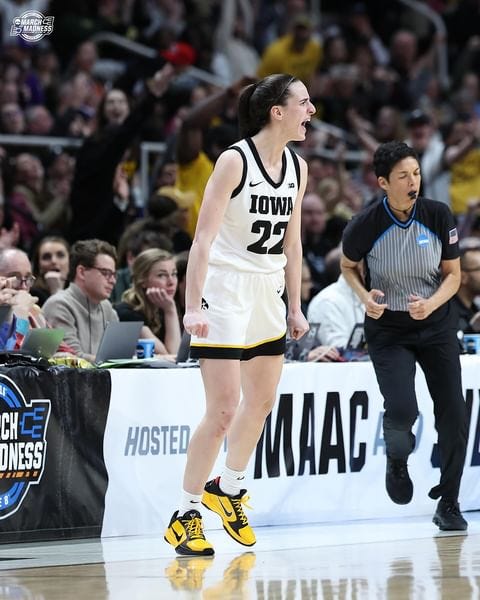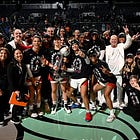Hi, friends.
What a weekend, huh?
The Sweet 16 and Elite 8 are in the rear-view mirror, and the Final Four is set: No. 1 South Carolina and No. 3 N.C. State will play at 7:00pm ET on ESPN on Friday night, followed by No. 1 Iowa and No. 3 UConn. The championship game will be on ABC Sunday afternoon at 3pm. It’s going to be awesome, and I’m lucky enough to be able to say that I’m going to be in Cleveland for all of it. (If you will be there too, please let me know!!)

The entire four days of women’s basketball was incredible. New stars were born, like NC State’s Aziaha James, who averaged 28 points per game and shot 68.9% from three in the two biggest games of her career. Existing superstars commanded the stage —Caitlin Clark had a combined 70 points, 27 assists, and 13 rebounds in two games; JuJu Watkins of USC, just a freshman, scored 30 in the Sweet 16 and 29 in the Elite 8; and Paige Bueckers was so impressive leading UConn back to the Final Four after a long one-year absences that *THE* Chamique Holdsclaw called her the “best all around women’s basketball player in college.” And undefeated South Carolina continued to establish supremacy, with All American Kamilla Cardoso anchoring what might be Dawn Staley’s deepest and most versatile team yet.
The best part? Everyone watched. I mean that literally. (Almost)
The ratings for the Sweet 16 and Elite 8 both smashed records, highlighted by 12.3 million people tuning in for Iowa’s 94-87 victory over defending champs LSU on Monday night. It was officially the most-watched women’s basketball game in the Nielsen era. Twelve. Point. Three. MILLION.
That number is exhilarating, it’s affirming, it’s jaw-dropping. And it also makes me just a little bit sad.
This potential has been there all along. The stars and the talent and the rivalries and the personalities and the commercial appeal have been hiding in plain sight for decades. And this potential wasn’t just hypothetical — there was proof that if you shone a spotlight on women’s basketball and told the stories of its players that people would tune in and watch.

It’s not capitalism holding women’s sports back. It’s male fragility.
As I wrote last year, the first NCAA women’s title game in 1982, which saw Louisiana Tech defeat Cheyney State, earned a “7.3 rating and 22 Nielsen share at noon on Sunday, March 28,” per Jack Bogaczyk of the Roanoke Times. For comparison, in 1983, CBS averaged a 7.2 rating for the NBA and a 5.2 rating for NCAA regular-season men’s games.
A staggering 11.84 million people tuned in for the 1983 championship game between USC and Louisiana Tech, according to Sports Media Watch. This was the national television debut of Cheryl Miller and the Women of Troy. In 1986, 11.22 million viewers tuned in to watch the final game of Miller’s college career, USC’s loss to Texas in the final.
Yes, Clark and Angel Reese are magnetic, groundbreaking forces of nature on and off the court, but you cannot have the conversation about transcendent talents and personalities in women’s college basketball without Miller. Here’s a clip from a Sports Illustrated profile of Miller in 1985:
Her captivating interpretive style has taken the sport to another level and added visibility and drawing power both locally and on the national scene. In Miller’s freshman season the Women of Troy broke 11 attendance records on the road and sold out four home dates. Since then the team has had to abandon the small campus gym and schedule its home games in the Los Angeles Sports Arena and elsewhere.
But, while Miller set the viewership standard, women’s basketball continued to put up strong numbers without her. Over the next decade, NCAA women’s basketball national championship games regularly notched more than seven million viewers, despite the fact that it was nearly impossible to find women’s basketball on television any other time of the year.
In 1995, 7.4 million people tune in to watch UConn beat Tennessee in the final. According to the New York Times, those ratings ratings “almost [tripled] the rating for Fox’s National Hockey League games, which aired at the same time, and [bettered] by 14 percent the rating for NBC’s pro basketball games.”
And yet, after that season, CBS let its rights to the women’s basketball tournament lapse, ESPN took them over, and it took 28 years for the women’s national championship game to make it back onto network television.
The drought ended last year, when the national championship game between LSU and Iowa was broadcast on ABC and drew 9.9 million viewers.
Women’s basketball is undoubtedly having a moment right now. Stars like Clark and Reese, coaches like Dawn Staley and Geno Auriemma, and off-court factors like social media and NIL have all heavily contributed to the equation. But it’s bigger than one player or one program. And it’s crucial to know that this moment is happening in spite of the fact that the NCAA didn’t allow the women’s tournament to use the term “March Madness” until TWO YEARS AGO; in spite of the fact that the NCAA’s very own revenue model actively disincentivizes investment in women’s basketball from universities and advertisers; in spite of the fact that ESPN didn’t broadcast every game of the tournament on national television until four years ago; and in spite of the fact that ESPN kept the women’s championship game off of network television for almost three decades.
So yes, I’m celebrating these numbers. I’m thrilled about the increased attention. I’m relishing the way things are changing for women in sports in front of our very eyes. But it’s hard not to think about what might have been.
In this section, we will quickly get caught up on news and results from around the women’s sports world, because it’s all connected, baby. The updates aren’t extensive and the list isn’t comprehensive, but it is a lot, and I try!
It was a big weekend in the NWSL! Here’s your weekly score update:

And here are the standings:

The Houston Dash played the role of spoiler in a chaotic, thrilling, and ultimately, for the 18,000 fans at PayPal Park in San Jose, California, disappointing home opener for Bay FC. The score was 1-0, Bay FC at halftime, but Diana Ordóñez equalized in the 66th minute. It looked like 1-1 might be the final score, but then the skies opened in the 87th minute— Ordóñez took a penalty kick, which was blocked by Lysianne Proulx, but Ordóñez followed it up and scored on her second chance, putting the Dash up 2-1. Then, three minutes into extra time, Bay FC picked up the pace and we got an absolute banger from Racheal Kundananji. Finally, just as it looked like Bay FC would salvage a point from the contest, Havana Solaun left footed a beautiful dagger right into the back of the net to give Houston its first win of the season.
While Kundananji’s goal didn’t get Bay FC over the finish line, she did make history as the first Zambian player to score a goal in NWSL history. She grabbed the Zambian flag from the sidelines for her celebration, and it was truly one of my favorite moments of the season so far.

Marisa Ingemi at the SF Chronicle wrote about the game, as did Marcus Thomson II at The Athletic.
Elsewhere in the NWSL, the Kansas City Current continued to be chaotic good; Sam Coffey scored a last-second banger to equalize the Portland Thorns vs. Racing Louisville FC clash; and Mallory Swanson scored the first goal of her comeback. (Try to not get emotional watching that celebration, I dare you.)
Still winless? The Orlando Pride, Racing Louisville FC, Portland Thorns, and Angel City FC. There’s a lot of season left, though.
The SheBelieves Cup, the worst-named tournament in the history of the world, kicks off this weekend. The USWNT will face Japan at 12:30pm ET on Saturday in Atlanta, followed by Canada vs. Brazil at 3:30pm ET. The winners of those two games will face off in the final on Tuesday in Columbus, and the losers will
Source link




















